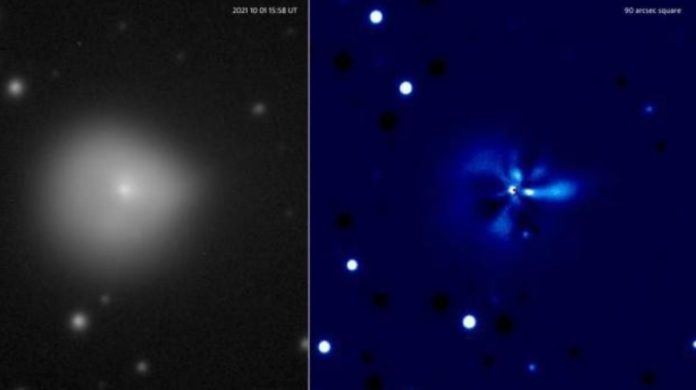Astronomers have been debating 29P’s behavior for years since it is so unpredictable.
The Comet 29P is an unusual object with a diameter of more than 60 kilometers, making it one of the largest bodies of its kind. Furthermore, it is one of the few centaur comets; that is, it orbits the Sun between Saturn and Jupiter, though it collides with the second gas giant every 50 years, altering its orbit and leading it to one of two possible destinations: the interior of the Solar System, closer to the Sun, or its icy confines. However, its peculiarities do not stop there: since its discovery in the 1920s, astronomers have discovered that it spontaneously explodes with spectacular bursts.
It ‘explodes,’ and no one knows why.
A new international observing campaign, including both professional and amateur astronomers, has been launched to unravel the enigma.
“You can’t predict when the comet erupts,” says Richard Miles, an amateur astronomer and former research scientist in hydrocarbon chemistry.
It is quite difficult for expert astronomers to devote sufficient time to the telescope in order to systematically watch these events.
On September 25, astronomers from the United States, Scotland, France, and Spain’s Tenerife island focused their telescopes toward the comet, which is positioned in the constellation Auriga. It was an excellent night to observe it, as the moonlight was dim. It occurred at that precise moment.
“We spotted several sequential eruptions,” says Miles, one of the observers that night.
“There were four obvious ones and then a fifth one at the end. After less than two days, the brightness of the comet was something like 250 times brighter than it was before it started becoming active.”
The strange activity had been previously investigated. Indeed, CSIC scientists revealed a decade ago that 29P experiences outbursts every 50 days and around seven light explosions each year on average. However, it lacks the precision of a clock, and the activity varies without a clear explanation. Indeed, this latest chain of explosions created a coma within the comet, a gaseous envelope characteristic of comets that persisted long enough for other observers to see.
“This would be the first time that we would catch the aftermath of such a big outburst,” says John Noonan, an astronomy graduate student at the University of Arizona.
Noonan was so enthused about the prospect of deciphering the secrets of 29P that he even submitted a request to use the Hubble space telescope to observe it.
“The previous times that Hubble looked at Comet 29P, it’s been for a smaller outburst. What’s happening now is quite unprecedented, at least in the last 40 years.”
Although the request was accepted, Hubble encountered problems that forced it into safe mode, rendering its optics inoperable for the time being (although astronomers hope that it can be seen in the next few days). They expect to differentiate debris released during the outbursts and track them away from the comet’s core.
If astronomers can follow such fragments, “they will be watching the birth of completely new comets,” explains Noonan.
An earlier analysis showed that comet 29P’s every half-century contact with Jupiter’s gravity may accelerate the cosmic ice ball into the Solar System as early as 2038, transforming the centaur into a considerably closer Jupiter family comet in roughly 10,000 years. If that is the case, astronomers may be on the verge of making a significant discovery about the processes that assist comets in their journey from the Kuiper Belt, the repository of space rocks beyond Neptune’s orbit, to the inner Solar System, where the rocky planets, including our planet, are located.
The unknowns of 29P
The reality is that astronomers know relatively little about this body and its bizarre behavior. They have no idea why the severity has suddenly increased. Comet activity is often determined by the Sun’s heat: the closer the frozen comet is to the star, the more material vaporizes. However, because 29P’s orbit is round, its distance from our star remains constant.
“It should therefore not display very pronounced variations in activity, said Noonan,” says Noonan.
However, there are outbursts. Thousands believe they are the product of complicated geological processes occurring both inside and outside the comet’s surface. The CSIC scientists argued that when small ice-rich parts of the comet are exposed to solar radiation, they undergo a sudden sublimation, which means they change from solid to gas swiftly. The pressure of this gas causes micrometer-sized particles to be dragged, resulting in outbursts capable of increasing the comet’s luminosity and producing jets of particles that expand from the nucleus to tens of thousands of kilometers, creating envelopes that reflect sunlight and can be seen even by astronomers’ telescopes.
A 2014 study discovered smaller ‘mini-explosions’ that occur between 10 and 15 times every year, firing material that falls back towards the comet’s surface, leaving a hard ‘crust.’ According to some scholars, this crust would break apart during the most severe eruptions, resulting in a greater eruption. 29P remains a mystery.
You were reading: A weird comet that explodes without warning and no one knows why
